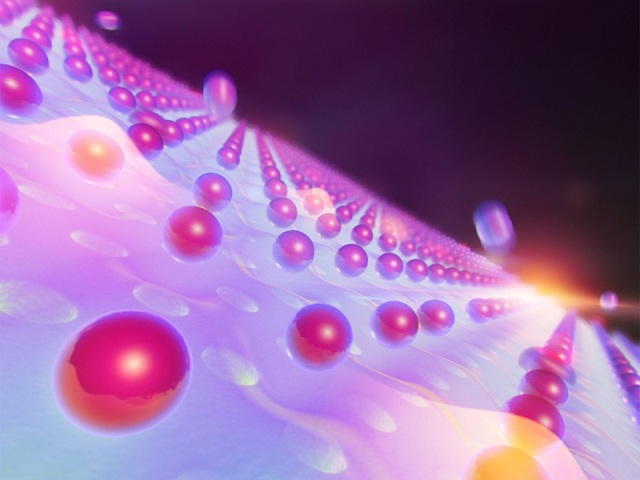Apr 20 2015
Researchers from the Max Planck Institute for Quantum Optics (MPQ), the California Institute of Technology (Caltech), and ICFO have suggested that combining the advantages of ultracold atoms and nano-photonics could help simulate quantum many-body systems and also create new states of matter.
 Illustration of the dielectric nano-photonic lattice for trapping atoms and making them interact. Graphic: MPQ, Theory Division
Illustration of the dielectric nano-photonic lattice for trapping atoms and making them interact. Graphic: MPQ, Theory Division
Crosswise superposition of laser beams generates optical lattices. Ultracold atoms in these optical lattices are very useful for simulating the behaviour of many-body systems, and they also help study their behavior in relation to their magnetic and electric properties. Solid crystals are an example of many-body systems. Factors such as the short interaction range, and the distance of around 400 nm between atoms affects implementation in free space.
Prof. Ignacio Cirac of MPQ, and Prof. Jeff Kimble of Caltech, along with a team of theorists, have proposed a new solution for bypassing the factors affecting the implementation in free space. The advantages offered by nano-photonics and ultracold atomic physics are integrated in a new set-up, with predicted lattice constants that are approximately ten times smaller than in free space optical lattices. This may also allow for mediation of longer range interactions.
Photonic Crystals, which are nano-engineered dielectrics, offer significant advantages for studying how to trap atoms that are closer to each other, and also how to induce them to interact through the structure’s guided modes. Due to this factor, the system’s range of the interactions and energy scales are increased, which would enable exploration of new forms of quantum many-body matter.
The study uses a thin dielectric slab. Holes are drilled or little cylindrical posts are installed in a grid-wise pattern, which periodically modulate the refractive index of the slab. A specific combination of vacuum forces and optics enables creation of lattices of up to 50 nm, which is approximately ten times smaller than optical lattices.
“With these subwavelength lattices we can investigate about the same quantum many-body phenomena as in free space optical lattices,” explains Dr. Alejandro González-Tudela, a scientist in the Theory Division of Prof. Cirac and first author of the publication. “But the difference and advantage of our proposed scheme is that the atoms are much closer to each other. That way we achieve higher tunneling rates and interaction energies for simulations of quantum many-body systems. And this implies that we can relax the cooling requirements of the atoms.”
The potential to conduct new kinds of physics is enabled by the smaller scale of the lattice and the two-dimensional thin dielectric layer’s geometry. This geometry enables the light that falls onto the slab to get trapped and guided. This allows an incoming photon to interact with an atom strongly and then bounce off. This photon does not go into space, but gets propagated through the waveguide, where it goes to find another atom and interacts with it. This process continues with the photon going to the next atom, interacting, and then going on to the next atom.
“Our analysis show that we should be able to achieve atom-atom-interactions, where the interaction mechanism is not by atom hopping (as in free space optical lattices) but by exchange of photons”, Alejandro González-Tudela says. “The result is a two-dimensional solid where the atoms are held together and talk to each other not by phonons – as in regular matter – but by photons. This implies a qualitatively new domain for light-matter interactions, with the capability to ‘design’ the strength and the range of the interactions. We would gain access to a rich set of phenomena, including, for example, quantum magnetism or spin-spin-interactions mediated by photons.”
This study has been published in Nature Photonics journal.